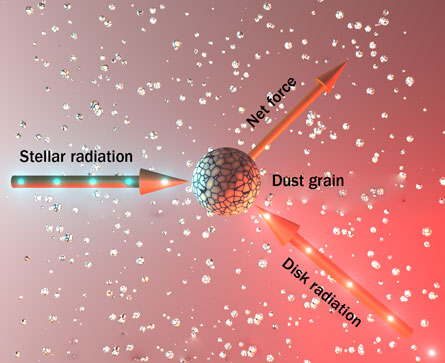View a video illustrating the process in action.

Astronomers report that they have cleared up a dusty puzzle about the composition of comets.
Infrared spectra of several comets taken two decades ago and an analysis in 2006 of the first cometary material brought back to Earth by spacecraft (SN: 3/25/2006, p. 182) indicated that the frozen bodies contained crystalline silicates, in the form of dust. But these findings present a conundrum because the dust can form only at temperatures much higher than those found in the birthing region of comets and the frigid outposts of the solar system where most comets roam.
Now two studies in the May 14 Nature — one based on observations, the other theoretical — reveal that crystalline silicates can form in the inner disk around an erupting star and suggest how the dust could travel billions of kilometers to the cold, outer part of the planet-forming disk, where comets coalesce.
The two studies “are very interesting in helping to resolve the long-standing problem about evidence for crystalline dust in places too cold for it to form,” demonstrating that comets are true amalgams of fire and ice, comments Sara Seager of MIT.
In the first report, Péter Ábrahám of the Hungarian Academy of Sciences’ Konkoly Observatory in Budapest and his colleagues used NASA’s infrared Spitzer Space Telescope to examine the composition of the planet-forming disk surrounding the young star EX Lupi. A similar disk of gas and dust is believed to have surrounded the infant sun, spawning the solar system’s retinue of planets, asteroids and comets.
Ábrahám and his collaborators compared infrared spectra of the inner disk recorded in April 2008, shortly after EX Lupi had undergone a large outburst, with spectra taken during 2005, when the star was quiescent. The 2005 spectra reveal the presence of amorphous silicate dust, which forms at relatively low temperatures. In contrast, the 2008 spectra show crystalline silicates, which can form only at temperatures greater than 1,000 kelvins.
The team says the differences in composition are proof that the blast of heat from the star’s outburst transformed the low-temperature amorphous silicates into the crystalline structure. In a commentary accompanying the Nature reports, astronomer Aigen Li of the University of Missouri in Columbia says the observations “for the first time present convincing evidence for the formation of crystalline silicates in the hot, inner disk around an eruptive star.”
In the second study, Dejan VinkoviÄ of the University of Split in Croatia suggests how such high-temperature silicates can travel billions of kilometers from the hot, inner disk to the cold, outer part of the planet-forming disk where comets are born. He proposes that the pressure exerted by radiation from the star combines with that from infrared radiation generated by the inner disk to push grains greater than 1 micrometer in diameter to the disk’s comet-forming outskirts.
In VinkoviÄ’s model, the infrared radiation lofts crystalline silicate dust just above the hot, inner disk. Once they’re floating there, the grains glide along the surface of the flat disk, pushed by the star’s radiation. As the particles travel over the colder, outer parts of the disk, where infrared light is too weak to keep them aloft, the grains drop back down, right into the region where comets form.
Previously proposed transport mechanisms, such as magnetically-generated winds from young stars or turbulent mixing of gases in the planet-forming disk, “all have assumptions that may be problematic,” says VinkoviÄ.
This animation shows the newly proposed mechanism for transporting
crystalline dust from the hot, inner part of a planet-forming disk to
the chilly outer regions where the material can be incorporated into
comets.
Credit: D. VinkoviÄ







